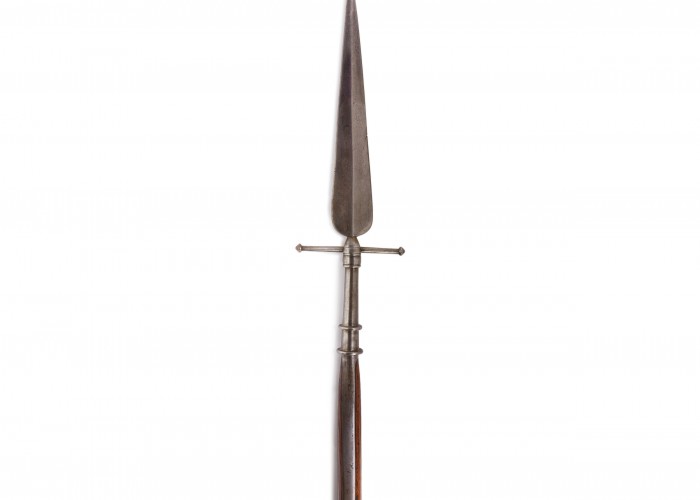Sergeant’s Spontoon
This is a short pike, or spontoon, carried by a sergeant, a non-commissioned officer in the British Army. This was a weapon of defence, discipline and authority. A long wooden shaft was topped with a steel spear point, just below which was a short metal cross bar. One intended use was to protect the regimental colours (King’s colour and Regimental colour) from being attacked and captured. The honour of guarding the colours was usually given to meritorious sergeants, one or more of whom would accompany a junior officer (ensign or lieutenant), to form a “colour party”.
The regulation spontoon (sometime known as an ‘espontoon’, ‘pike’ or ‘half pike’ and also loosely known as a ‘halberd’) was around 7- 9 feet in length and was in common use from the mid-17th to early 19th century. The short cross metal cross bar was to keep the blade from penetrating too deeply into the body of an enemy – which would make it hard to withdraw the weapon. In defence, it had a long reach and was a smaller version of the 15 foot pikes wielded in the English Civil War. A spontoon was of use when infantry had to repel cavalry, an advantage given by the long reach. As muskets replaced pikes, the latter became more a symbol of authority and discipline. Common soldiers stopped carrying pikes, which were used solely by sergeants. It was carried by centre company sergeants (i.e. not by the light or grenadier company sergeants).
In combat and drill the sergeant could place the long pole horizontally behind soldiers’ backs to keep ranks straight, or to prod people into position. Because of the height of the spontoon, it was easy for all to identify the position of the sergeant in action. Three spontoons lashed together in a triangle formed a frame against which a man undergoing punishment by the lash could be tied.
Issued by the Board of Ordnance, there was a standard drill for ‘order’, ‘shoulder’ and ‘port’ arms etc. as with firearms. When muskets were stacked in camp, after the order to ‘pile’ arms was given, the spontoons could be placed horizontally between two piles of muskets.
-
Curatorial info
- Originating Museum: National Army Museum
- Accession Number: NAM. 1968-10-4-9
- Production Date: 1821
-
Use this image
You can download and use the high resolution image for use in a non-profit environment such as a school or college, but please take note of the license type and rights holder information below
- Rights Holder: Copyright National Army Museum.
- License Type: Creative Commons








